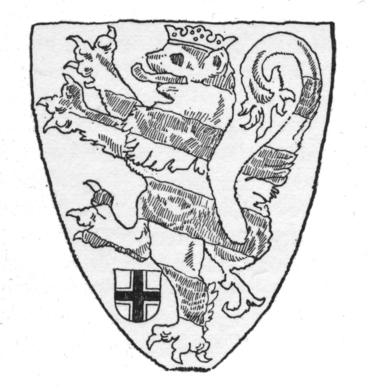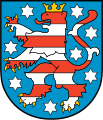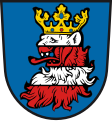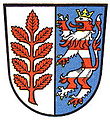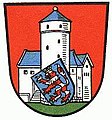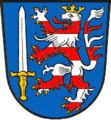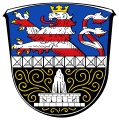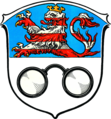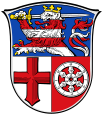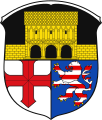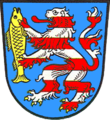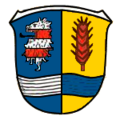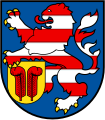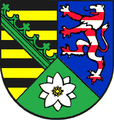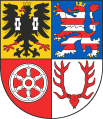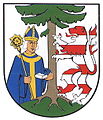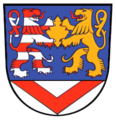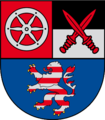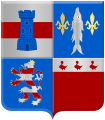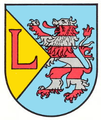Colorful lion
The colorful lion is a common figure in coats of arms , namely a red-tongued and gold-reinforced, rising lion divided several times (usually nine times) by silver and red or also by red and silver (colloquially: a white-red or red-white horizontal in mostly five Pairs of strips of striped, erect lion, looking in the direction of stride, with red tongue and golden claws), always in a blue shield . It is found almost exclusively in coats of arms with current or historical references to Hesse or Thuringia and is then also called the Hessian Lion (also " Hessian Lion ") or Thuringian Lion (also "Thuringian Lion").
history
The colorful lion has been known as a heraldic animal since the early 13th century . It is the coat of arms of the Ludowinger , the Thuringian ruling dynasty.
As seals have been proving since 1200, the Landgraves of Thuringia already led the rising lion in the shield. While the crown and the typical stripes of the heraldic animal are not attested sphragistically , the heraldic shield for Landgrave Konrad von Thuringia (1206-1240), who joined the Teutonic Order in 1234 , tells of the division of the lion, initially probably of red and white, and its crowning. Literary evidence up to the last quarter of the 13th century is added; the Song of Troje (around 1210), like Konrad von Mure and the epic about the “Tournament of Nantheiz”, speak of the shield colors. Consciously tradition preserving the first Landgrave of Hesse took over Henry I of the House of Brabant not only the Thuringian lion as emblem, but also the crest , the silver (sometimes gold) outside with leafy branches besteckten buffalo horns; In 1492 there is talk of birch leaves.
The oldest representation of the colorful lion in a coat of arms is the shield (in the sense of a protective weapon) of Konrad von Thuringia, from around the year 1234. The shield shows a lion soaring in blue, divided into red and white seven times, with the German coat of arms between its rear paws Order. It hung temporarily in the Marburg Elisabeth Church as a death shield ; Meanwhile it is exhibited as an exhibit in a collection of the University Museum for Art and Cultural History of the Philipps University of Marburg in Marburg Castle .
The coat of arms of Konrad of Thuringia at the foot of his tomb in the Landgrave Choir of the Elisabeth Church in Marburg is slightly younger (probably 1240, the year of Konrad's death) - on the left the coat of arms of the Teutonic Order.
- Coat of arms of Konrad of Thuringia
The origin of the coat of arms is controversial. A declaration states that the design is based on the association of coats of arms after the marriage of Ludwig the Fourth of Thuringia to Elisabeth of Hungary , the daughter of the Hungarian King Andreas II. In 1221. Ludwig IV. Was Landgrave of Thuringia and Count Palatine of Saxony from 1217 to 1227 . At that time, Hesse and Thuringia still formed a common landgraviate.
After the division of the Landgraviate into Hesse (which became an independent Landgraviate) and Thuringia in the Langsdorf Peace of 1263, the colorful lion was used to mark both territories. The Margraves of Meissen acquired Thuringia through the inheritance and now carried on the title of Landgrave of Thuringia. The Electorate of Hesse and the Prussian Province of Hesse also ran the Colorful Lion.
Hessian and Thuringian lion
Both can be found in the coats of arms of Hessian and Thuringian districts, cities and communities. The order of the color strips is not uniform; historically, silver clearly predominates as the topmost stripe. It was not until the later 20th century that the following convention was established, which also corresponds to the current coat of arms of Hesse and Thuringia :
- The Hessian lion begins with silver on the head.
- The Thuringian lion begins with red on the head.
However, this is not normative; In blazons , the sequence of stripes must also be expressly indicated (as "division") if the lion is referred to as Hessian or Thuringian. Whether a colored lion is referred to as a Hessian or Thuringian lion depends solely on the context of its use (explicit mention in the blazon, coat of arms, etc.), not on the color of the top stripe. If the context of use is not known (or is neither Hessian nor Thuringian), only the neutral designation "Bunter Löwe" is appropriate.
In today's coats of arms of Hessian places, the variant with a silver head is found almost without exception, while both forms occur in Thuringian coats of arms. In particular, Thuringian towns that used to belong to Hesse or that show historical connections to Hessian mansions in their coat of arms have the Hessian lion in their coat of arms. In other Thuringian coats of arms, the lion is also called the “Thuringian lion” when its head is silver.
In the coat of arms of the Free State of Thuringia , the lion is accompanied by eight silver stars . These have been referring to the eight parts of the country since 1945 (based on the model of the national coat of arms from 1921 without lions with seven stars for the seven parts of the country at the time) and are not included in local coats of arms together with the lion.
Examples
State coats of arms of Hesse and Thuringia
Rising lion in the coat of arms of Hesse
(white lion head)Rising lion in the coat of arms of Thuringia
(red lion head)Thuringia regional command of the Bundeswehr
Hessian lion in the Hessian district coat of arms
District of Eschwege (until 1974)
District of Frankenberg (until 1974)
Obertaunuskreis (until 1972)
District of Marburg (until 1974)
Melsungen district (until 1974)
District of Schlüchtern (until 1974)
Witzenhausen district (until 1974)
Hessian lion in the Hessian local coat of arms
Colorful lion with a red head in the Hessian coat of arms
Hessian lion in the Thuringian district of Schmalkalden
The former district of Herrschaft Schmalkalden belonged to the Prussian province of Hessen-Nassau until 1944 . In 1945, after the end of the war, it was assigned to the district of Erfurt as the district of Schmalkalden and is therefore now part of Thuringia, as a part of today's district of Schmalkalden-Meiningen .
Thuringian lion in the Thuringian district coat of arms
Thuringian lion in Thuringian local coat of arms
Colorful lion with a silver head in the Thuringian coat of arms
Colorful lion outside of Hesse and Thuringia
Coat of arms of Wattrelos (France) and Sint-Amandsberg and Oostakker (Belgium)
Bornem coat of arms (Belgium)
Coat of arms of Le Ham (France)
Coat of arms of Bonyhád ( Bonnhard , Hungary)
Bill Clinton's personal coat of arms
Coat of arms of Neustadt (Dosse) , Ostprignitz-Ruppin district
Coat of arms of the Verbandsgemeinde Pirmasens-Land , district of Südwestpfalz
Coat of arms of the local community Ludwigswinkel , district of Südwestpfalz
Coat of arms of the local community Vinningen , district of Südwestpfalz
Coat of arms Coburg Land (Bavaria)
Remarks
- ↑ The shield is u. a. Subject of Helmut Nickel: About the Grand Master's coat of arms of the Teutonic Order in the Holy Land . In: Der Herold, quarterly for heraldry, genealogy and allied sciences . 13, Volume 33, Issue 4, 1990, pp. 106 ( Scan [PDF]).
- ↑ The crown and the outstretched tongue shown in the drawing of the shield are present in the photo of the shield, but are difficult to see. It can be assumed that Max Reinhart , author of the sketch , strictly followed the template.
Individual evidence
- ↑ Gert Oswald : Lexicon of Heraldry. Bibliographisches Institut, Leipzig 1984, p. 83, (3rd, unchanged edition. Battenberg, Regenstauf 2011, ISBN 978-3-86646-077-5 ).
- ^ Klemens Stadler : The municipal coat of arms of the state of Hesse . New edition of the collection of German local coats of arms by Prof. Otto Hupp on behalf of HAG Aktiengesellschaft in Bremen, edited by Dr. Klemens Stadler, drawings by Max Reinhart (= German coat of arms - Federal Republic of Germany . Volume 3 ). Angelsachsen-Verlag, Bremen 1967, p. 6 .
- ^ Shield of the Landgrave Konrad of Thuringia. In: bildindex.de
- ^ Main statute of the city of Frankenberg (Eder). (PDF) April 28, 2016, p. §1 (2) , accessed on September 10, 2017 . - Description of the coat of arms: "The city of Frankenberg (Eder) has a blue coat of arms, a lion growing out of a golden three-mountain, crowned in gold and reinforced with gold, divided three times by silver and red."


